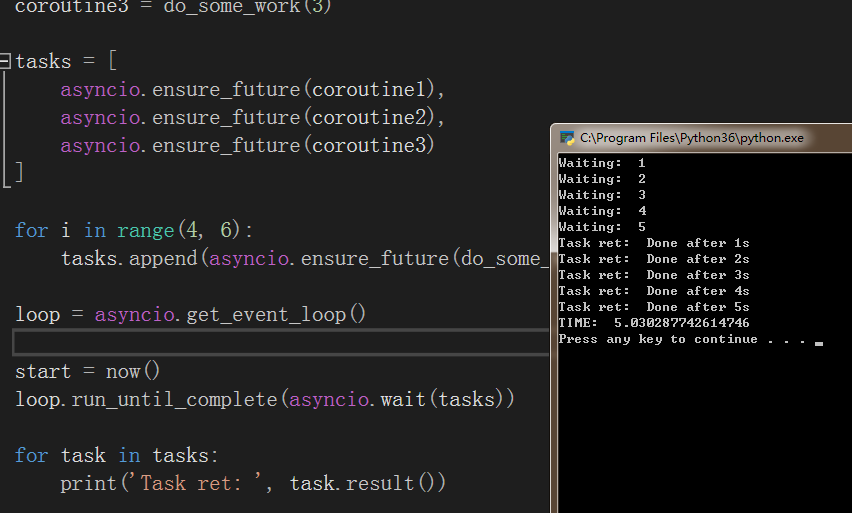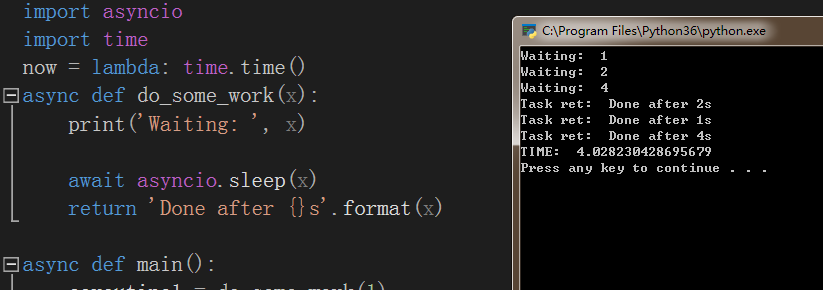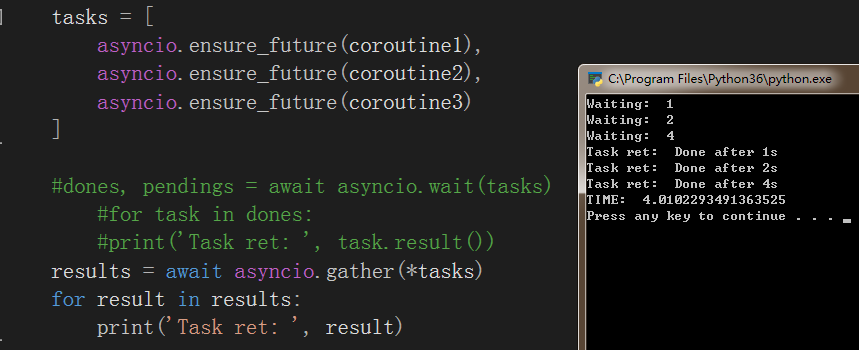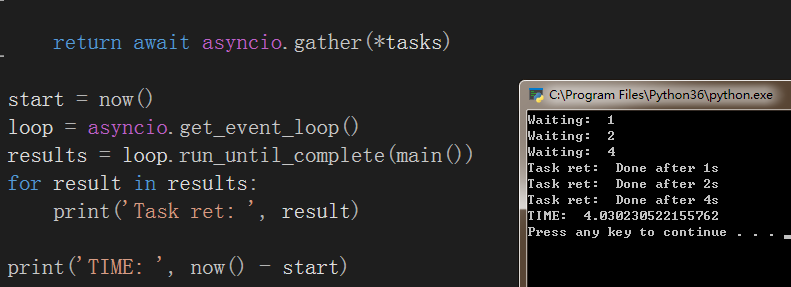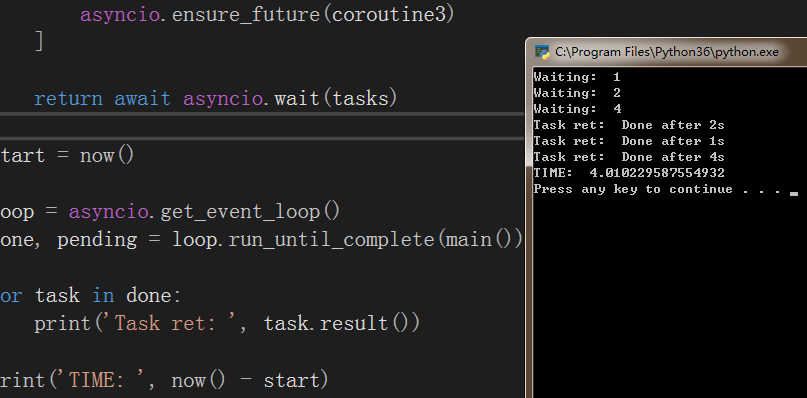六】协程并发
定义tasks时可以设置多个ensure,也可以像多线程那样用append方法实现
[python] view plain copy
- tasks = [
- asyncio.ensure_future(coroutine1),
- asyncio.ensure_future(coroutine2),
- asyncio.ensure_future(coroutine3)
- ]
- for i in range(4, 6):
- tasks.append(asyncio.ensure_future(do_some_work(i)))
当遇到阻塞时可以使用await让其他协程继续工作
例如:
[python] view plain copy
- import asyncio
- import time
- now = lambda: time.time()
- async def do_some_work(x):
- print('Waiting: ', x)
- await asyncio.sleep(x)
- return 'Done after {}s'.format(x)
- coroutine1 = do_some_work(1)
- coroutine2 = do_some_work(2)
- coroutine3 = do_some_work(3)
- tasks = [
- asyncio.ensure_future(coroutine1),
- asyncio.ensure_future(coroutine2),
- asyncio.ensure_future(coroutine3)
- ]
- for i in range(4, 6):
- tasks.append(asyncio.ensure_future(do_some_work(i)))
- loop = asyncio.get_event_loop()
- start = now()
- loop.run_until_complete(asyncio.wait(tasks))
- for task in tasks:
- print('Task ret: ', task.result())
- print('TIME: ', now() - start)
通过运行时间可以看出aysncio实现了并发。asyncio.wait(tasks) 也可以使用 asyncio.gather(*tasks) ,前者接受一个task列表,后者接收一堆task。
【七】协程嵌套
使用async可以定义协程,协程用于耗时的io操作,我们也可以封装更多的io操作过程,这样就实现了嵌套的协程,即一个协程中await了另外一个协程,如此连接起来。
例如:
[python] view plain copy
- import asyncio
- import time
- now = lambda: time.time()
- async def do_some_work(x):
- print('Waiting: ', x)
- await asyncio.sleep(x)
- return 'Done after {}s'.format(x)
- async def main():
- coroutine1 = do_some_work(1)
- coroutine2 = do_some_work(2)
- coroutine3 = do_some_work(4)
- tasks = [
- asyncio.ensure_future(coroutine1),
- asyncio.ensure_future(coroutine2),
- asyncio.ensure_future(coroutine3)
- ]
- dones, pendings = await asyncio.wait(tasks)
- for task in dones:
- print('Task ret: ', task.result())
- start = now()
- loop = asyncio.get_event_loop()
- loop.run_until_complete(main())
- print('TIME: ', now() - start)
如果使用的是 asyncio.gather创建协程对象,那么await的返回值就是协程运行的结果。
[python] view plain copy
- #dones, pendings = await asyncio.wait(tasks)
- #for task in dones:
- #print('Task ret: ', task.result())
- results = await asyncio.gather(*tasks)
- for result in results:
- print('Task ret: ', result)
不在main协程函数里处理结果,直接返回await的内容,那么最外层的run_until_complete将会返回main协程的结果。
[python] view plain copy
- import asyncio
- import time
- now = lambda: time.time()
- async def do_some_work(x):
- print('Waiting: ', x)
- await asyncio.sleep(x)
- return 'Done after {}s'.format(x)
- async def main():
- coroutine1 = do_some_work(1)
- coroutine2 = do_some_work(2)
- coroutine3 = do_some_work(4)
- tasks = [
- asyncio.ensure_future(coroutine1),
- asyncio.ensure_future(coroutine2),
- asyncio.ensure_future(coroutine3)
- ]
- return await asyncio.gather(*tasks)
- start = now()
- loop = asyncio.get_event_loop()
- results = loop.run_until_complete(main())
- for result in results:
- print('Task ret: ', result)
- print('TIME: ', now() - start)
或者返回使用asyncio.wait方式挂起协程。
[python] view plain copy
- import asyncio
- import time
- now = lambda: time.time()
- async def do_some_work(x):
- print('Waiting: ', x)
- await asyncio.sleep(x)
- return 'Done after {}s'.format(x)
- async def main():
- coroutine1 = do_some_work(1)
- coroutine2 = do_some_work(2)
- coroutine3 = do_some_work(4)
- tasks = [
- asyncio.ensure_future(coroutine1),
- asyncio.ensure_future(coroutine2),
- asyncio.ensure_future(coroutine3)
- ]
- return await asyncio.wait(tasks)
- start = now()
- loop = asyncio.get_event_loop()
- done, pending = loop.run_until_complete(main())
- for task in done:
- print('Task ret: ', task.result())
- print('TIME: ', now() - start)
也可以使用asyncio的as_completed方法
[python] view plain copy
- import asyncio
- import time
- now = lambda: time.time()
- async def do_some_work(x):
- print('Waiting: ', x)
- await asyncio.sleep(x)
- return 'Done after {}s'.format(x)
- async def main():
- coroutine1 = do_some_work(1)
- coroutine2 = do_some_work(2)
- coroutine3 = do_some_work(4)
- tasks = [
- asyncio.ensure_future(coroutine1),
- asyncio.ensure_future(coroutine2),
- asyncio.ensure_future(coroutine3)
- ]
- for task in asyncio.as_completed(tasks):
- result = await task
- print('Task ret: {}'.format(result))
- start = now()
- loop = asyncio.get_event_loop()
- done = loop.run_until_complete(main())
- print('TIME: ', now() - start)
